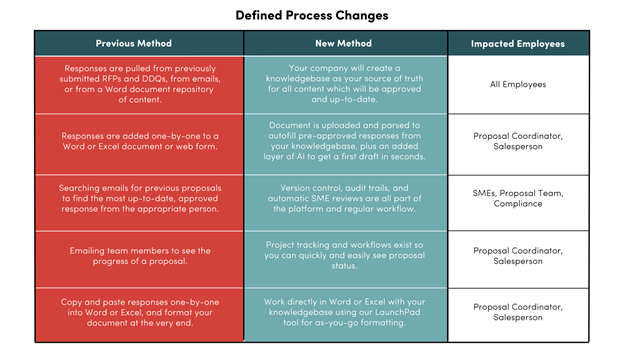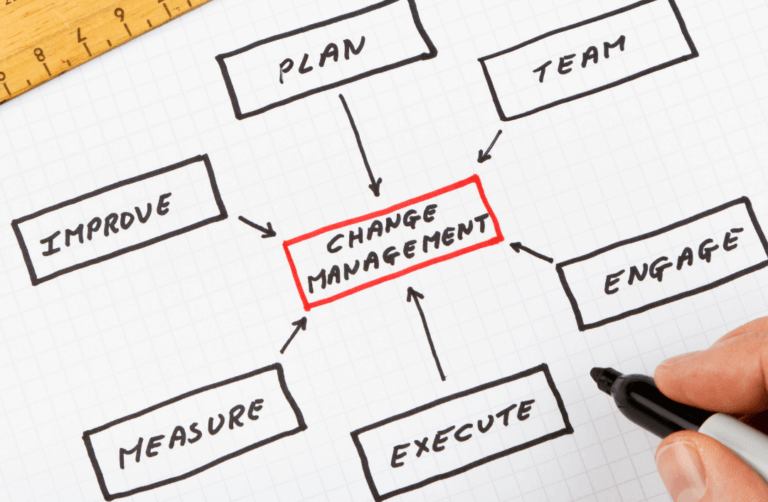Change is inevitable. For leaders, what this means is that the ability to effectively manage said change is absolutely crucial for long-term success. Whether implementing new technologies, restructuring teams, or shifting strategic goals, a well-defined change management plan can ensure a smooth transition (no matter the scope of the change).
Case in point: a study by KPMG revealed that 37% of executive teams underestimate the impact of organization-wide change and the models used to make them. In addition, up to 70% of change initiatives fail outright. What steps can be taken to overcome any challenges that arise?
At RocketDocs, we believe that understanding how to create a successful change management plan empowers organizations to navigate internal change confidently and efficiently. Let’s talk about what a change management plan entails, and how to make a foolproof one.
Defining Change Management
Change management is simply blanket terminology for any structured approach to guiding individuals, teams, and organizations from their current state to a desired future state. It involves planning, implementing, and monitoring changes to achieve specific objectives while mitigating risks and minimizing resistance. The main goal should be to ensure that changes are smoothly and successfully integrated into the organization, and that everyone involved is “bought in” and ready to commit.
Goals and Benefits of a Change Management Plan
A solid change management plan can be a game-changer for any organization. Just as Google Maps helps you on your daily commute, imagine having a clear roadmap that not only shows the way but also highlights potential bumps along the journey, ensuring everything runs on schedule.
Communication barriers are broken down, meaning everyone is kept in the loop and on the same page. Resources are used properly, cutting down on waste and maximizing the impact of every effort. Disruptions to daily operations are minimized, making the transition smoother and quicker. Plus, by identifying and addressing risks early, the plan helps avoid any unwelcome surprises down the line.
Effectively managing change not only addresses the technical aspects of the shift but also the oft-elusive “human element”, ensuring that all stakeholders are aligned and supportive of the transformation. All too often, changes get implemented only partially within an organization, leading to stagnation and lost opportunities for growth. To avoid this, it’s crucial to ensure that your team understands the “why” behind the change on all levels, and works together to make it happen.
Types of Organizational Change
So, in the context of business, what exactly is change?
1. Fundamental Change: Involves significant shifts such as mergers, acquisitions, or large- scale restructuring. These changes often require comprehensive planning and a long-term perspective.
2. Transformational Change: Focuses on major improvements in systems, processes, or technologies. This type of change aims to enhance organizational performance and competitiveness.
3. Developmental Change: Entails quick adjustments to address immediate challenges or opportunities. These changes are typically smaller in scope but can be crucial for maintaining operational efficiency.
Change Management Strategies
To get further in the weeds for a moment, there are a variety of time-tested methods and strategies for managing change within an organization. We won’t cover every single one in this guide, but let’s briefly look at three of the most flexible below.
ADKAR Model
ADKAR. An acronym worth getting to know that encapsulates:
– Awareness: Ensure stakeholders are aware of the need for change.
– Desire: Foster a desire to support and participate in the change.
– Knowledge: Provide knowledge on how to change.
– Ability: Develop the ability to implement the change.
– Reinforcement: Reinforce the change to sustain it.
This model was originally developed by change management company Prosci, and represents a tried and true approach to navigating just about any change.
Kubler-Ross Change Curve
The Kubler-Ross model is one you’ve probably heard of, because it is one commonly associated with grief. It maps out the emotional responses individuals may experience during change, such as shock, denial, frustration, and acceptance. Understanding these stages helps in addressing emotional challenges.
Lewin’s Change Management Model
One of the foundational models for understanding organizational change was developed by Kurt Lewin in the 1940s and remains relevant today. His model, known as Unfreeze – Change – Refreeze, outlines a three-stage process for implementing change.
Lewin, who was both a physicist and a social scientist, used the analogy of changing the shape of a block of ice to explain how organizations can transition from one state to another. This model emphasizes preparing for change, implementing the change, and then solidifying the new state.
Key Components Every Change Management Plan Needs
Robust Description of Change
Clearly articulates what is changing within the organization. This includes detailing new processes, technologies, roles, or structures being introduced.
Clear Context and Rationale
Explains why the change is necessary. Ideally provides as much background information as possible, such as market trends, competitive pressures, or internal inefficiencies, that justify the need for change.
Thorough Impact Analysis
Identifies which parts of the organization will be affected by the change. This includes departments, teams, and specific roles, as well as the anticipated impact on workflows and productivity.
Identifies Who’s In Charge
All individuals and groups involved in or affected by the change should be included in your plan. It should define their roles, responsibilities, and level of influence over the change process. The clearer you are here, the less trouble you’ll have during the infamous “messy middle” period.

Defined Resources and Budget
Details the resources required to implement the change, including financial, human, and technological resources. Ideally, this should also outline the budget and allocate funds appropriately to support the change initiative.
Timeline and Milestones
Provides a detailed timeline that outlines the phases of the change process. It’s usually best to include key milestones and deadlines to ensure the project stays on track.
Specific Goals and Objectives
Clear, measurable goals should be set for the change initiative. These should align with the organization’s overall strategic objectives and provide a basis for evaluating the success of the change.
Steps to Create a Change Management Plan
1. Define the change (and how significant it is)
Change can be hard when the goals and scope of the transformation are too vague or not understood by everyone involved. Collaborate with your team to map the current processes, identify areas for improvement, and define the desired changes. At this stage your focus should be on identifying how large or small the desired change will be, as well as ensuring that the new process is aligned with your strategic goals.
2. Create and communicate the core plan
Now it’s time to develop the skeletal structure of your change management plan and communicate it effectively to all stakeholders. This is where the bulk of the action is, and you’ll want to use a tried-and-true method to make creating the plan easier. For example, you might use the ADKAR model to tailor messages for different groups within your organization.
3. Decide how you’ll handle training
Come up with a training program that addresses the needs of various user groups. Consider their existing knowledge and the new skills required to adapt to the change. With larger, systemic changes, you should take care to ensure that everyone involved has a clear understanding of their responsibilities.
4. Implement the change
Roll out the change in stages, closely monitoring progress and making adjustments as needed. Ensure continuous support and feedback mechanisms are in place. This affords you a bit of security, as too much change too quickly can often be disruptive to day-to-day operations.
5. Celebrate success and reinforce the change
Once you’ve done the work, take a step back and appreciate what you’ve accomplished. Recognizing and celebrating milestones and successes is a proven way to maintain momentum. Over time, reinforce the change by sharing positive outcomes and optimizing processes based on continual feedback. Chances are, you won’t get it perfect the first time (but if you do, even better!)
How RocketDocs Can Help
Because change is a constant, having a solid plan for how to navigate it professionally is vital. At RocketDocs, we recognize the importance of streamlining operations wherever possible, which is why we’ve built the most comprehensive response management platform on the market today.
Changing to a new platform for your response management needs might seem daunting, but with our comprehensive onboarding, training, and help desk resources, we ensure your team knows exactly how to use the platform and receives support when needed, removing potential frustrations.
For more information, be sure to check out our other resources below:



